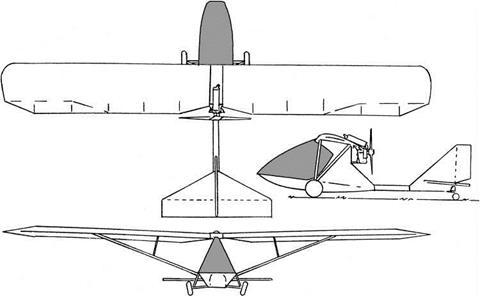Commercial and Kit-Built Ultralight Airplanes
There are three classes of commercial and kit-built ultralight airplanes, each with interesting stability and control characteristics. Using the terminology of the influential Jane ’sAll the World’s Aircraft, the most simple is the classical modern hang glider, developed from the Rogallo wing (Rogallo et al., 1960). Control is obtained by shifting body weight, as in the nineteenth-century Lilienthal hang gliders. The next level of sophistication is called a parawing. It is a powered ram air parachute. Finally, there is the broad category of microlights. These airplanes range from powered hang gliders to lightly constructed airplanes of conventional layout. Like the hang glider, microlights use fabric-covered light structures.
The FAA in the United States and the CAA in the United Kingdom have each developed certification provisions for ultralight airplanes, FAR Part 103 (1990) and BCAR Section S-CAP 482, respectively. FAR Part 103 applies to unpowered ultralights weighing less than 155 pounds and powered ultralights weighing less than 254 pounds; powered ultralights have top speeds less than 55 knots and stalling speeds less than 24 knots. Part 103 specifically exempts these ultralights from meeting airworthiness standards. Operating rules only are specified. Other countries use the FAA and CAA standards for their own certifications.
A comprehensive review of hang-glider stability and control is presented by Anderson and Ormiston (1994). Longitudinal trim is provided by reflexed airfoil shapes. Directional stability is generally positive because of wing sweep. Geometric dihedral is adjusted for neutral spiral stability at cruise. A surprising finding is low Dutch roll stability at low angles of attack. This has led to pilot-induced oscillations, augmented by inadvertent swing of the body in response to side accelerations. Hang-glider full-scale tests on an outdoor mobile test rig were conducted at Cranfield University (Cook and Kilkenny, 1987).
The stability and control characteristics of powered hang gliders, called flexwing airplanes by the author, were discussed by Brooks (1998). Turn control of these machines is unconventional, as in the case of the Gossamer Condor. To turn right, the pilot’s weight is moved to the right by exerting force to the left on the control frame base bar. The weight moment and aeroelastic wing flexing (right wing washout) combine to start a right roll. Adverse yaw causes right sideslip. Anhedral, or negative dihedral effect, increases the right rolling moment, accelerating the turn.
|
Figure 13.1 Chinook WT-11 ultralight airplane, general arrangement. (From Roderick, 1986) |
A brief wind-tunnel test of the fabric-covered wing and tail surfaces of a Chinook WT-11 ultralight airplane (Figure 13.1) conducted in the Canadian NAE 9m by 9m low-speed wind tunnel (Roderick, 1986) showed some unusual characteristics. There was noticeable wing twist at higher dynamic pressures, which decreased wing lift curve slope. With the elevator deflected, the horizontal tail had nonlinear lift curves near its stall. The investigators concluded that a large amplitude pitch down at the stall was a possibility.
Aside from the technical findings of these investigators, experience has shown that inadvertent stalling is a major cause of ultralight accidents. Operators of ultralights under U. S. FAR Part 103 are not required to pass knowledge or experience tests. However, avoidance of inadvertent stalling during the demanding operations of approach and landing requires careful training.












